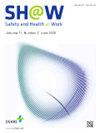Health Outcomes Related to Multiple Exposures in Occupational Settings: A Review
IF 2.9
3区 医学
Q1 PUBLIC, ENVIRONMENTAL & OCCUPATIONAL HEALTH
引用次数: 0
Abstract
Individuals are constantly exposed to hazardous factors that can affect their health, the hazards encountered in the workplace can lead to the development of occupational diseases. Risk mitigation measures help to reduce the risks, but they are often designed without consideration of interactions between occupational exposures. Therefore, there is a need for research and it resulted in international research plans and programmes. The aim of this scoping review is to provide an overview of the scientific results related to the link between multiple occupational exposures and human health outcomes. Sixty-three articles were reviewed. Research articles were included only if they mentioned: several combined exposures, the direct characterisation of each exposure, and exposure/health outcome associations. Seven activity sectors were identified: ‘extraction and energy production and distribution’, ‘health care’, ‘banks, public administration and defence’, ‘chemical production’, ‘manufacturing industry’, ‘agriculture and food industry’ and ‘transport and logistics’. Six multiple exposures scenarios were identified: chemical (n = 35), chemical/physical-biomechanical (n = 22), chemical/psychosocial-organisational (n = 6), physical-biomechanical (n = 9), physical-biomechanical/psychosocial-organisational (n = 13), and psychosocial-organisational (n = 12). The health problems identified concern nervous, mental, respiratory, musculoskeletal, auditory and other systems. Eighty-eight of 97 (91%) multiple exposure/health problem associations were reported to be statistically significant. Twenty studies (32%) provided specific risk prevention advice for multiple exposures. Prevention aimed at reducing risks to workers' health is still underdeveloped, further research is needed to improve prevention methods. No study was related to biological risk, and some other multiple exposures known to have health effects were not identified as well. This highlights the need for more multiple exposures research.
职业环境中多重暴露相关的健康结果:综述
个人不断接触可能影响其健康的危险因素,在工作场所遇到的危害可能导致职业病的发展。风险缓解措施有助于降低风险,但这些措施的设计往往没有考虑到职业暴露之间的相互作用。因此,有必要进行研究,并由此产生了国际研究计划和方案。本次范围审查的目的是概述与多种职业接触与人类健康结果之间的联系有关的科学结果。共审查了63篇文章。研究文章只有在提到以下内容时才被纳入:几种组合暴露、每种暴露的直接特征以及暴露/健康结果的关联。确定了七个活动部门:“开采和能源生产和分配”、“保健”、“银行、公共行政和国防”、“化学生产”、“制造业”、“农业和食品工业”以及“运输和物流”。确定了6种多重暴露情景:化学(n = 35)、化学/物理-生物力学(n = 22)、化学/心理-社会-组织(n = 6)、物理-生物力学(n = 9)、物理-生物力学/心理-社会-组织(n = 13)和心理-社会-组织(n = 12)。确定的健康问题涉及神经、精神、呼吸、肌肉骨骼、听觉和其他系统。据报告,97例(91%)多重暴露/健康问题关联中有88例具有统计显著性。20项研究(32%)提供了针对多重暴露的具体风险预防建议。旨在减少工人健康风险的预防工作仍不发达,需要进一步研究以改进预防方法。没有研究与生物风险有关,也没有确定其他一些已知对健康有影响的多重接触。这凸显了更多多重暴露研究的必要性。
本文章由计算机程序翻译,如有差异,请以英文原文为准。
求助全文
约1分钟内获得全文
求助全文
来源期刊

Safety and Health at Work
Social Sciences-Safety Research
CiteScore
6.40
自引率
5.70%
发文量
1080
审稿时长
38 days
期刊介绍:
Safety and Health at Work (SH@W) is an international, peer-reviewed, interdisciplinary journal published quarterly in English beginning in 2010. The journal is aimed at providing grounds for the exchange of ideas and data developed through research experience in the broad field of occupational health and safety. Articles may deal with scientific research to improve workers'' health and safety by eliminating occupational accidents and diseases, pursuing a better working life, and creating a safe and comfortable working environment. The journal focuses primarily on original articles across the whole scope of occupational health and safety, but also welcomes up-to-date review papers and short communications and commentaries on urgent issues and case studies on unique epidemiological survey, methods of accident investigation, and analysis. High priority will be given to articles on occupational epidemiology, medicine, hygiene, toxicology, nursing and health services, work safety, ergonomics, work organization, engineering of safety (mechanical, electrical, chemical, and construction), safety management and policy, and studies related to economic evaluation and its social policy and organizational aspects. Its abbreviated title is Saf Health Work.
 求助内容:
求助内容: 应助结果提醒方式:
应助结果提醒方式:


